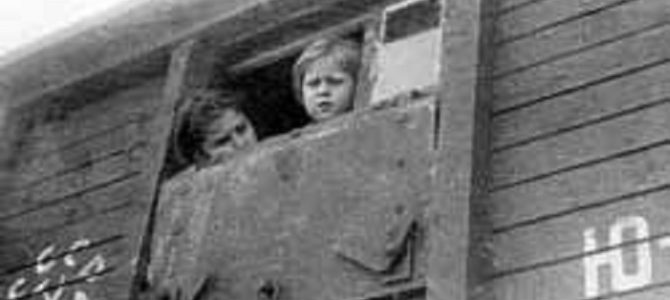
At 3 o’clock in the morning on June 14, 1941, NKVD officers began mass arrests of Lithuanian citizens. Entire families of Lithuanians and Jews were deported to Siberia deep in the Soviet Union. More than 30,000 people from Lithuania were taken away in one week. They were sent to Siberia in sealed rail cars.
Lithuania marks this anniversary as the Day of Mourning and Hope in honor of those who died in exile.
The deportations of June, 1941, was an enormous loss for Lithuania. The deportations affected all social strata and all ethnic groups. Thousands were torn from their homes and families, lost their property and means of making a living and sent into the worst sort of living conditions surrounded by alien cultures and a hostile environment. The deportees were physically exterminated in prisons, camps and selected deportation sites. A total of around 33.6 percent of deportees returned to Lithuania and 26.5 percent died. The fate of over 40 percent of deportees is still unknown but are assumed dead. The destruction of families and deportation to places unfit for life, directly leading to death, is judged a crime against humanity and an example of genocide by an occupying power against the people of Lithuania.
The first Soviet occupation of Lithuania in 1940 was a real blow to Jews as well. All Jewish institutions were closed down, property was nationalized and a large number of Jews were sent along with ethnic Lithuanians to the camps in the east.
As Solomonas Atamukas writes in his new book “Lietuvos žydų keliai. Atmintis, tikėjimas, viltis” (2018), under Lithuanian Soviet Socialist Republic NKGB order no. 0023 of April 25, 1941 issued to prepare the way for new deportations, the NKGB compiled lists of “anti-Soviet and counter-revolutionary elements.” NKGB categories for scheduling deportations included:
“Land owners, large factory owners, wholesale merchants and owners of buildings, the Jewish national counter-revolution: the heads of all Zionist organizations and permanent employees of press enterprises, Bund leaders and permanent employees of their press organs. Also [members of] the Union of Jews who Fought in the Battles for Lithuanian Independence, Jewish combatants (soldiers), the Beitar union (youth Zionist union), the EL-AL organization and the Revisionist Party.”
From 1940 to 1941 a total of 2,613 Jews were targeted for repression. Among those, 1,660 were deported and 385 became political prisoners. Between June 14 and 18, 1941, the absolute majority of deportees and political prisoners ended up in the gulag. According to unverified sources, 375 Jews died in the camps and in exile.
The deportations of 1941 accounted for about 1.3 percent of members of the Jewish community in Lithuania at that time. Thus Jews were the most highly targeted ethnic group in Lithuania, including ethnic Lithuanians (approximately 0.5 percent). Jews in exile maintained their cultural identity and the Zionist organizations continued underground. There were also underground schools to teach Hebrew.

